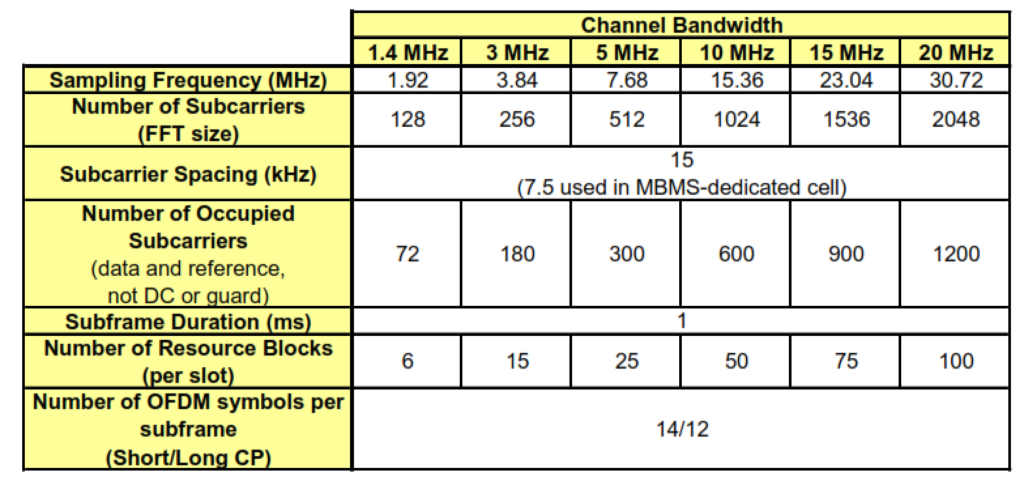The LTE air interface is the crucial interface of the LTE (Long Term Evolution) network, responsible for the wireless communication between the user equipment (UE) and the base stations (eNodeB). It is designed to support high data rates, low latency, and efficient spectrum usage, enabling the delivery of high-speed mobile broadband services.
The LTE air interface uses Orthogonal Frequency Division Multiple Access (OFDMA) for the downlink and Single Carrier Frequency Division Multiple Access (SC-FDMA) for the uplink. It supports both Frequency Division Duplex (FDD) and Time Division Duplex (TDD) air interface schemes.
FDD requires paired frequencies, one for downlink and one for uplink, while TDD shares the same frequency for downlink and uplink. Information regarding Multimedia Broadcast/Multicast Service (MBMS) is not included in this section at this time.
1. OFDMA.
OFDMA (Orthogonal Frequency Division Multiple Access) is a method used to encode and modulate digital information. It sends data over a channel using a series of symbols on multiple subcarriers.

Here’s how it works:
- Subcarriers: The channel’s bandwidth is split into evenly spaced subcarriers. These subcarriers are designed to be orthogonal, meaning they don’t interfere with each other.
- Two Dimensions: An OFDMA channel can be thought of as having two dimensions:
- Frequency Dimension: This is represented by the subcarriers.
- Time Dimension: This is represented by symbols.
- Symbols: Each OFDMA symbol carries information on a specific subcarrier at a specific time. A symbol can be represented in both the time domain (how it changes over time) and the frequency domain (how it is spread across frequencies).
This technique helps efficiently manage and transmit data by minimizing interference and maximizing the use of available bandwidth.
2. Number of Subcarriers.
The number of subcarriers (also known as FFT or Fast Fourier Transforms) is based on the channel size. For example, a 1.4 MHz channel bandwidth is divided into 128 subcarriers (128 FFT), while a 20 MHz channel bandwidth uses 2048 subcarriers (2048 FFT).
The OFDM subcarrier spacing and symbol characteristics are identical, only the FFT size and channel bandwidth vary. Since the subcarrier center frequencies are equally spaced across the channel bandwidth, the subcarrier spacing can be calculated using the following equation: Subcarrier Spacing = Sampling Frequency / Number of Subcarriers
For example, a 1.4 MHz channel has a sampling frequency of 1.92 MHz and 128 subcarriers, so the subcarrier spacing is calculated by 1.92 MHz/128, which equals 15 kHz. The Subcarrier Spacing is 15 kHz for all channel bandwidths.
3. Symbol Size.
Symbol Time:
- This is the time duration during which data bits are transmitted across all subcarriers at the same time.
- It is the inverse of the subcarrier spacing. For LTE with 15 kHz subcarriers, the symbol time is 66.67 microseconds.
- The transmitted OFDMA waveform’s duration for each subcarrier is called the symbol time.
Guard Interval and Cyclic Prefix:
- A guard interval is added between symbols to prevent interference between them (inter symbol interference).
- This is done using a Cyclic Prefix (CP), which is a copy of the last part of the symbol inserted at the beginning of the symbol.
- The cyclic prefix helps collect multipath signals at the receiver and maintains the orthogonality of the subcarriers.
- The total duration of a transmitted symbol is the symbol time plus the cyclic prefix.
LTE defines two Cyclic Prefix sizes: normal and extended.
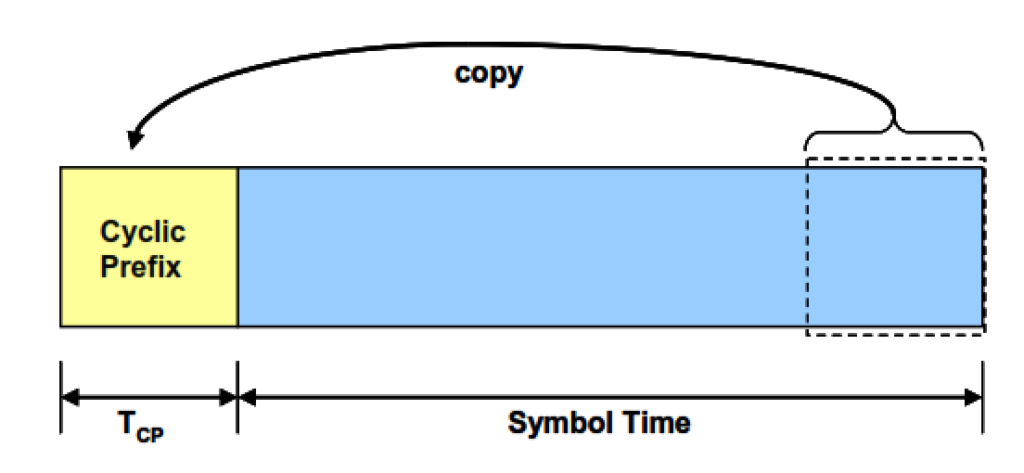
4. Subcarrier Types.
There are various types of subcarriers: DC Subcarriers, Guard Subcarriers, Data Subcarriers, and Reference Signals. These subcarrier types are shown in the figure below.
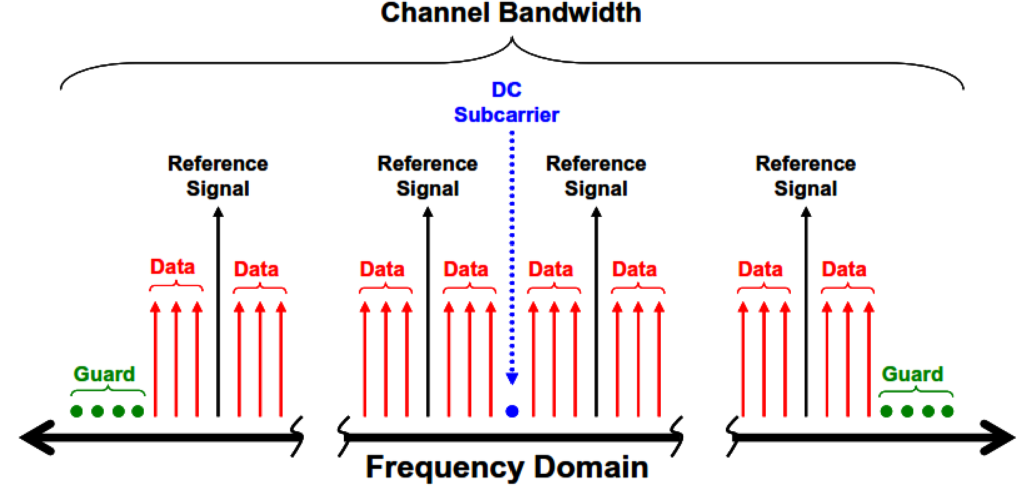
The DC and Guard subcarriers are not used to carry data or reference information. They are set to null (i.e. not powered). As seen in the diagram, the DC subcarrier is the subcarrier associated with the channel center frequency. The Guard subcarriers are used to eliminate inter-channel interference between LTE channels.
The Data and Reference subcarriers carry data and reference information, respectively. The Data subcarriers are used to carry bearer data and control messages. The Reference Signals are used to estimate RF channel characteristics (signal quality) and are distributed across the subcarriers. Occupied subcarriers include Data subcarriers and Reference Signals but not Guard subcarriers or DC subcarriers.
5. Frames.
OFDM combines numerous symbols into frames. Each physical layer frame is 10 milliseconds long (i.e. 100 frames are transmitted per second), for both FDD and TDD. As previously mentioned, FDD uses different frequencies on the downlink and uplink and these frequencies are assigned in pairs. Each frequency uses a separate frame.
For TDD, the same frequency is used for downlink and uplink. Downlink and uplink traffic are carried in the same frame, though DL and UL subframe allocations may vary, refer to Table below. FDD uses LTE frame Type 1; TDD uses LTE frame Type 2, which includes time gaps to switch the transmission direction. Both types of frames are 10 milliseconds long.

D = Downlink subframe.
U = Uplink subframe.
S = Special subframe.
FDD – Type 1 Frame.
The following diagram shows the structure of a Type 1 FDD downlink frame. The 10 millisecond frame is divided into 20 slots (numbered 0 through 19), each 0.5 milliseconds long. A frame is also divided into 10 subframes, each 1 millisecond long, where two adjacent slots form one subframe. Each subframe contains 14 or 12 symbols, depending upon the length of the cyclic prefix.

When a normal cyclic prefix is used, a slot contains 7 symbols. When an extended cyclic prefix is used, the slot contains 6 symbols. The extended cyclic prefix size is 16.67 microseconds. In the case of the normal cyclic prefix, there are two different sizes. The cyclic prefix is slightly larger for the first symbol than for the other symbols. The cyclic prefix size for the first symbol is 5.21 microseconds and 4.69 microseconds for symbols 1 through 6.
Bandwidth within the slots is allocated on resource blocks (RB). A resource block is 180 kHz (i.e. 12 subcarriers) in the frequency domain and 1 slot in the time domain, as seen in the following figure. A resource element (RE), which is 1 subcarrier in the frequency domain by 1 symbol in the time domain, may carry modulated data or a reference signal. When using a normal cyclic prefix, a resource block contains 84 resource elements (12 subcarriers by 7 symbols). When using an extended cyclic prefix, a resource block contains 72 resource elements (12 subcarriers by 6 symbols).
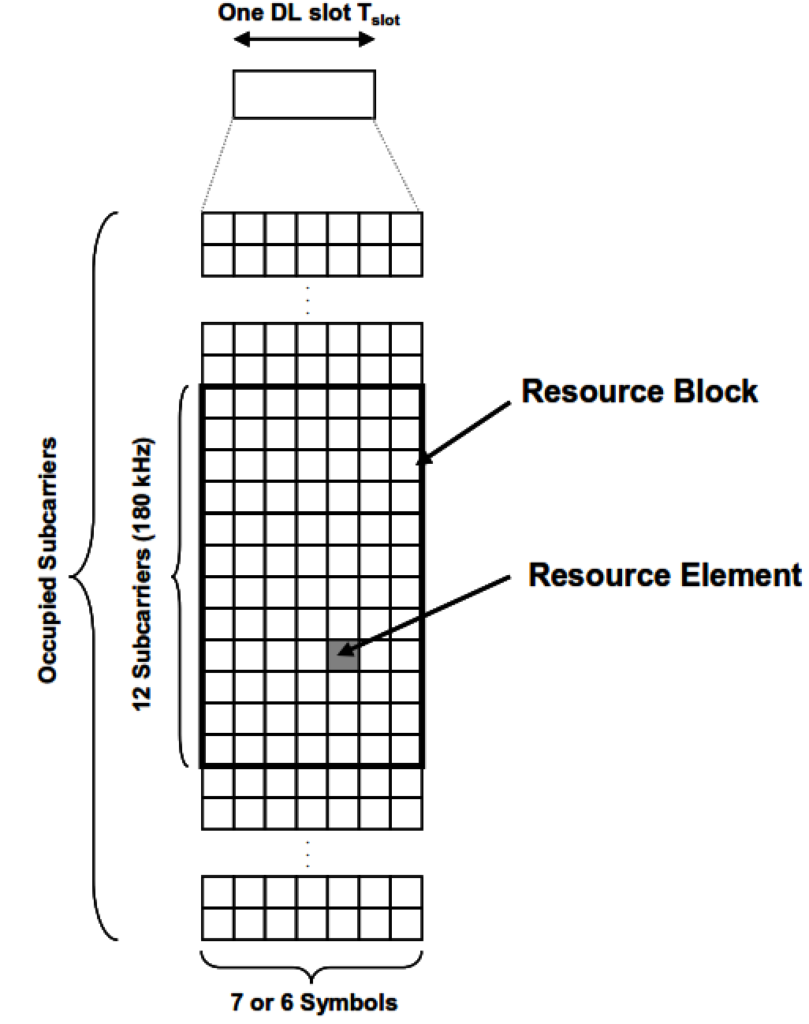
The following formula is used to determine the number of resource blocks per slot:
Resource Blocks per slot = Occupied Subcarriers / Subcarriers per Resource Block.
For example, for a 5 MHz channel bandwidth, the number of resource blocks per slot is 25 (i.e. 300/12) (refer to Table below). The downlink and uplink paths use different numbers of reference signals. For the downlink, 4 reference signals are distributed in the resource block for a single port antenna.
Two and four port antennas use different DL reference signal patterns for each port. Two port antennas use an 8 reference signal pattern for the downlink, while four port antennas use a 12 reference signal pattern for the downlink. For the uplink, an entire symbol time is devoted to carrying reference signals.
All of the resource elements not designated to reference signals may be used to carry modulated data or control information. The following figure shows the downlink reference signal patterns. Note that this diagram shows resource blocks with normal sized Cyclic Prefixes.

TDD – Type 2 Frame.
Frame Type 2 is used exclusively for TDD operation. As with the FDD frame, the TDD frame is 10 milliseconds long and contains 10 subframes (numbered from 0 to 9), each 1 millisecond long. A subframe consists of two adjacent slots, except for ones designated as a special subframe. Each slot is 0.5 milliseconds long, as seen in Figure below.
For TDD, certain subframes are set up for certain functions. Subframes 0 and 5 are reserved for downlink traffic. Subframe 2 must contain uplink traffic. Subframe 1 is a special subframe. A special subframe always occurs at the switch between DL to UL, to provide a guard period. Subframe 6 may be used for either a downlink or a special subframe. If subframe 6 is a special subframe, then subframe 7 will be for uplink traffic. Also, subframes 3, 4, 7, 8, and 9 are either UL or DL.
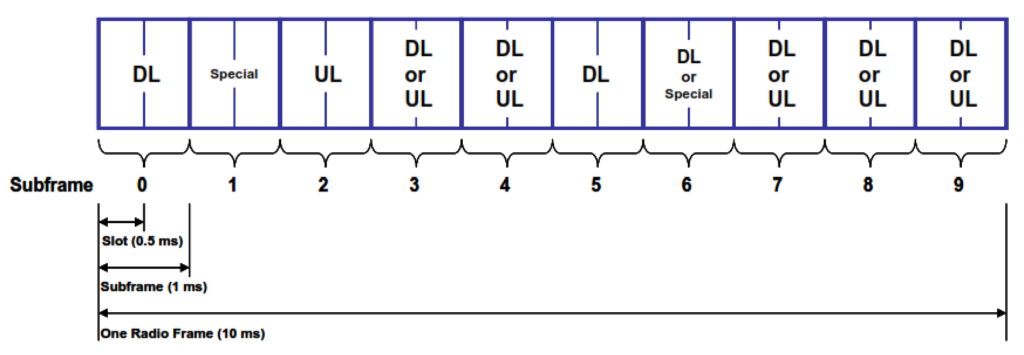
A special subframe contains the following fields: Downlink Primary Timing Signal (DwPTS), Guard Period (GP), and Uplink Primary Timing Signal (UpPTS). The DwPTS field contains downlink control and downlink data transmissions, as well as the primary timing (slot synchronization) signal for the downlink and uplink directions.
The UpPTS field may be used for UL Sounding Reference Signals. The Guard Period provides a downlink to uplink guard interval. The total length of the DwPTS, UpPTS, and Guard Period equals 1 millisecond. The following figure shows the structure of a special subframe.

There are seven UL/DL configurations for Frame Type 2. Each configuration contains either one or two special subframes. Thus, two switching periodicities are supported: 5ms or 10 ms switching.
FDD-TDD Frame Summary.
The following table provides a summary of basic information regarding Frame Type 1 (FDD) and Frame Type 2 (TDD).
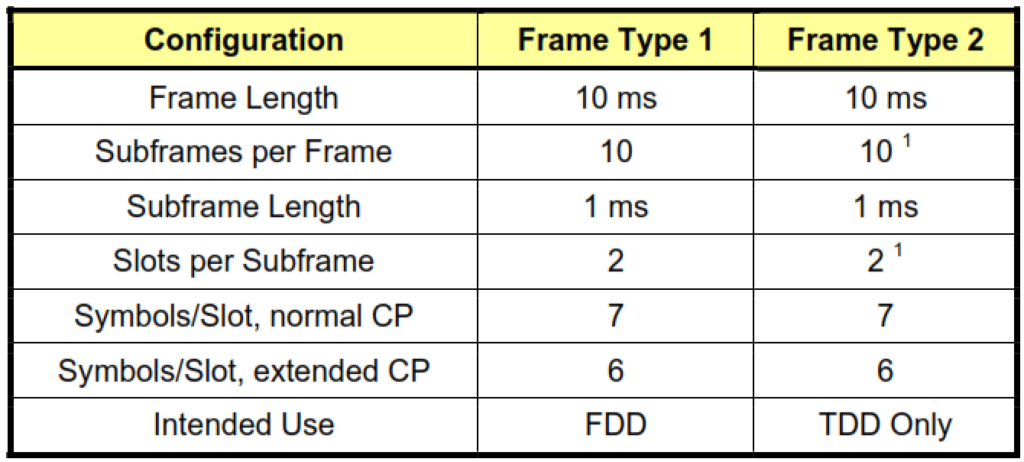
6. UL Allocation (SC-FDMA).
As mentioned previously, LTE uses OFDMA on the DL. It allocates DL bandwidth to the user based on resource blocks, rather than individual subcarriers. When the signal is a combination of subcarriers, high amplitude power peaks can occur. The base stations power amplifiers are designed to handle the resulting high peak-to average power ratio.

Although the eNodeB is fully capable of transmitting and receiving OFDMA symbols, the subscriber units must balance reduced complexity and lower transmit power requirements with support for high data rates and good QoS at cell boundaries. OFDMA is not used on the UL.
For the UL, SC-FDMA was selected to meet those requirements. SC-FDMA helps with peak-to-average power reduction by adding extra encoding steps. In OFDMA, each data stream is transmitted in a separate subcarrier. However, with SCFDMA, multiple data streams are transmitted in the same subcarrier and symbol time. The “sub-symbols” are spread over multiple subcarriers. Each SC-FDMA symbol contains 12 sub-symbols transmitted at the rate of 12 times 15 KHz. The following diagram illustrates this.
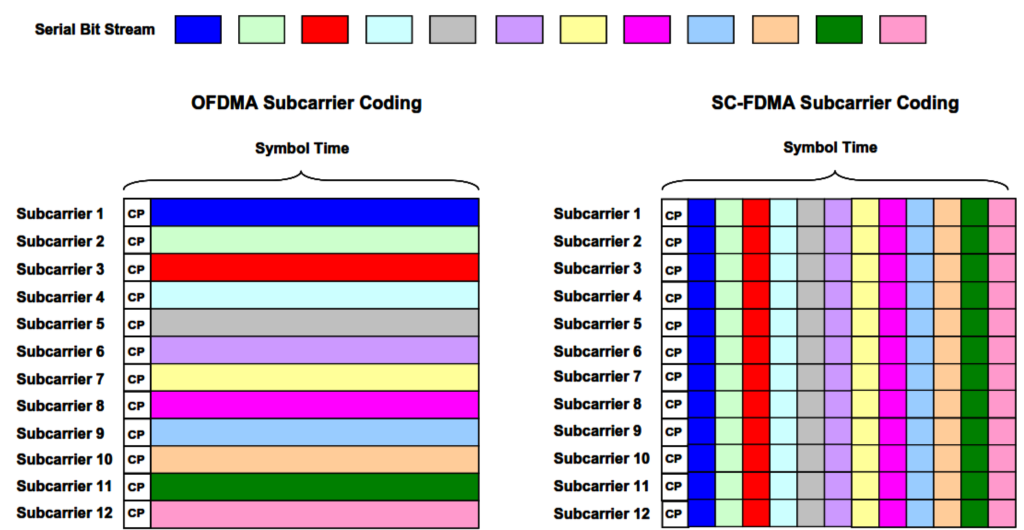
Unlike OFDMA, the SC-FDMA signal appears to be more like a single carrier, with each data symbol represented by a wide signal spanning the 12 subcarriers of the resource block.
7. Modulation Techniques.
LTE devices use different methods to modulate data and control information. These methods are:
- QPSK (Quadrature Phase Shift Keying): Carries 2 bits per symbol.
- 16QAM (16-Quadrature Amplitude Modulation): Carries 4 bits per symbol.
- 64QAM (64-Quadrature Amplitude Modulation): Carries 6 bits per symbol.
- Downlink: All three techniques (QPSK, 16QAM, and 64QAM) are supported.
- Uplink: QPSK and 16QAM are supported; 64QAM is optional.
Modulation Selection
The modulation technique is chosen based on the signal to interference plus noise ratio (SINR):
- Low SINR (farther from eNodeB): Uses QPSK, which is more robust but has lower throughput.
- High SINR (closer to eNodeB): Uses 64QAM, which is less robust but has higher throughput.
Measuring Signal Quality
- Both the eNodeB (base station) and the UE (user equipment) measure signal quality using Reference Signals, which carry a known bit pattern at a higher power level.
- The eNodeB decides and selects the modulation and coding scheme for both the downlink and uplink based on these measurements.
8. Error Correction.
Forward Error Correction (FEC) adds redundant bits to the transmitted data enabling the receiver to correct errors without requesting retransmission. Tail biting convolution coding is used on the DL and UL control channels. All DL and UL traffic channels use turbo coding.
LTE Overview Summary.
The following table summarizes some of the key numbers that are associated with LTE,
as discussed above.
